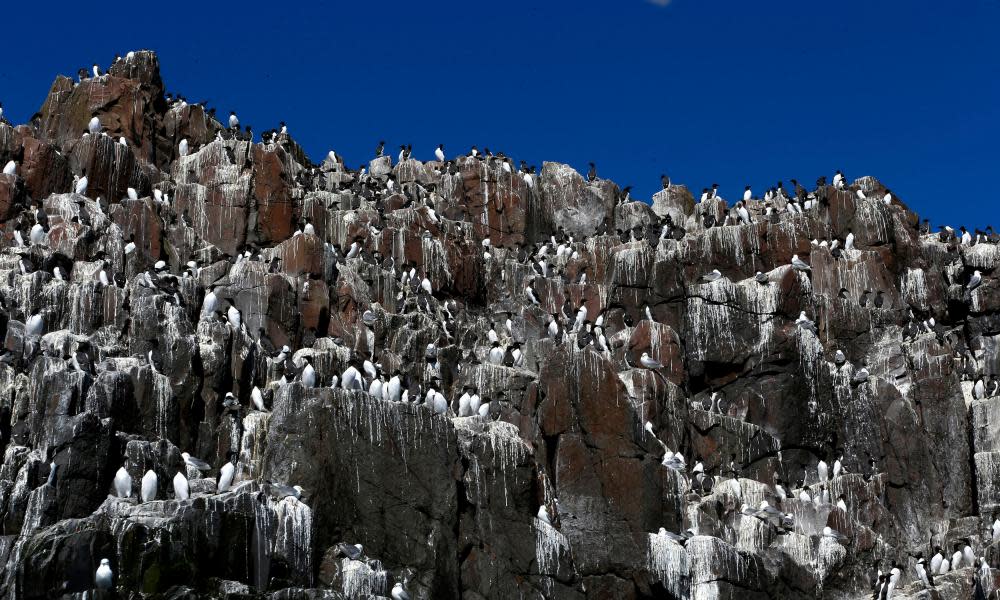We must stop seabird numbers falling off a cliff. After all, we’re to blame | Adam Nicolson

About 70,000 tonnes of seabird are now afloat or on the wing off the shores of the British Isles. This biomass – roughly the same as Salisbury Cathedral – is made up entirely of thinking, fishing, hunting, flirting, fighting, flying, diving and feathered beauty: 8 million breeders, several million more adolescents and, by the end of the summer, armies of chicks. Perhaps 15 million creatures in all.
They are here for sex, and the raising of the next generation. Eggs can’t be laid on the sea; bird embryos breathe air through the shell and would suffocate in water.
Every coastal culture on Earth has evolved a double attitude to seabirds – using and loving them, nurturing and killing them, experimenting with them and selling them, looking at them with awe and making toys, hats and dinner out of them. They were never merely walking or flying larders but, as the archaeologists Marcus Brittain and Nick Overton have called them, “participants in life”, fellow beings, co-actors in the drama and struggle of existence. Stillborn children were buried on the wings of whooper swans in Mesolithic Denmark. At Isbister in Orkney, more than 600 sea eagle bones were mixed in with human remains in a bronze age tomb. In Shetland shepherds used to feed titbits to the bonxies – great skuas – that protected their lambs from sea eagles and ravens. Even now, Hebridean fishermen keep seagulls as pets in their gardens beyond the kitchen door.
For generations, their mystery and power has been in their ability to come and go beyond any horizon. Now, thanks to technology – almost entirely fuelled by the miniaturisation drive of the mobile phone industry – we know what these birds do when beyond that horizon: wandering albatrosses sail five million miles in a lifetime’s voyaging around the Southern Ocean; each puffin holds within its mind a map of the North Atlantic, tracking across it to the same unmarked parts year after year; shearwaters smell their way around their 20,000-mile migrations from northern nest sites to southern fishing grounds in a two-hemisphere life of unbroken summer.
But just as science is coming to understand the seabirds, we are destroying them. By one measure, in the past 60 years they have declined by two thirds, from about 1.5 billion to something like 500 million.
The extension of the graph into the future reaches zero in about 2060. That won’t happen – the seabird phenomenon is too complex, with too many unknowns and local variations. But a disaster is unfolding, and it is one we have brought on ourselves: through overfishing; the massive accidental catching of birds in fishing gear; their deliberate destruction; introducing rats, cats, dogs, pigs, goats, rabbits and cattle to the breeding places of birds that are defenceless because they did not evolve with the introduced species (many Pacific birds literally cannot smell a rat); pollution by oil, metals, plastics and other toxins; the recently discovered fact that plastic that has long been floating in the ocean comes to smell like food, so 90% of all seabirds are now found to have plastic in their stomachs; the destruction of nesting sites by human development; and the multiple effects of climate change and the acidification of the sea.
The details are horrible. Fulmars and other species are being caught by Spanish longliners; they are drowning in gill nets, which hang in the sea and are designed to trap fish by the gills but are just as effective at catching birds; and they are being killed under the heavy cables behind trawlers, where they gather to feed on offal. In European seas, fulmar numbers have declined by 40% over the past 30 years. They are predicted to crash by the same percentage again in the next 50.
It is the same story for the world’s 11 million puffins. They will be 80% down by the second half of this century, and a rare sight anywhere south of the northernmost islands in Scotland. The tufted and horned puffins, of which there are about five million in the Pacific, are also declining. Their cousins, the guillemots and razorbills, are suffering too, with sharp losses in Iceland, one of the headquarters of auk life, with big colonies losing almost half their birds in the three or four years after 2005. There are now some 20 million kittiwakes strung around the northern hemisphere, but in places the population has halved in number since 1983.
What is to be done? All that can be done. We must not preside over the ending of these marvels. Most of the practicalities are obvious: there needs to be a much wider understanding of the state of the world’s seabirds; their breeding places need to be protected from people and their predatory animals; much tighter controls must be imposed on all kinds of fishing vessels so that fewer birds are killed at sea; and, because the death rate of adult birds in winter has more influence on seabird populations than any other single factor, their winter feeding grounds need to be understood, mapped and protected – particularly the great oceanic upwellings off the continents.
Finally, and most intractably, the rate at which we are changing the atmosphere and the ocean, both its temperature and its acidity, needs to be brought under control. Donald Trump’s relighting of the fires under global warming is to be accompanied by the cutting of funds to the US nature agencies. In the UK, groundbreaking censuses of seabirds were made in 1970, 1985 and 2000. There should have been one in 2015, but shamefully it was thought unnecessary and never carried out. The destruction will romp into the future. And unless we change our minds, it will also happen in the dark.

 Yahoo News
Yahoo News 
